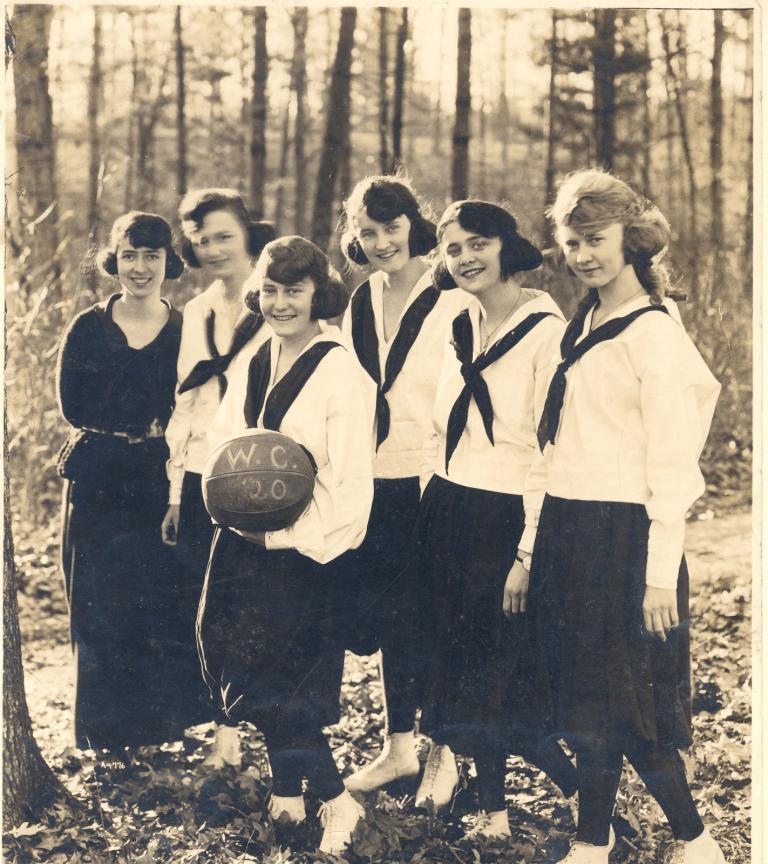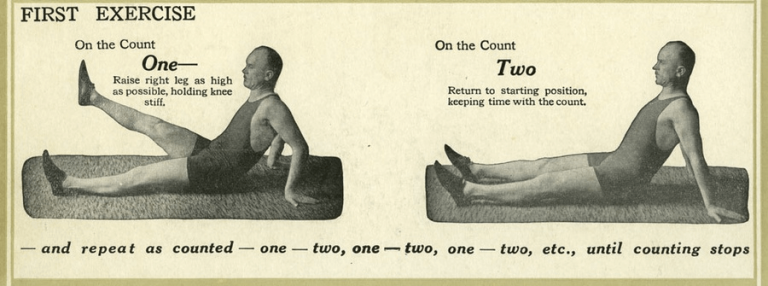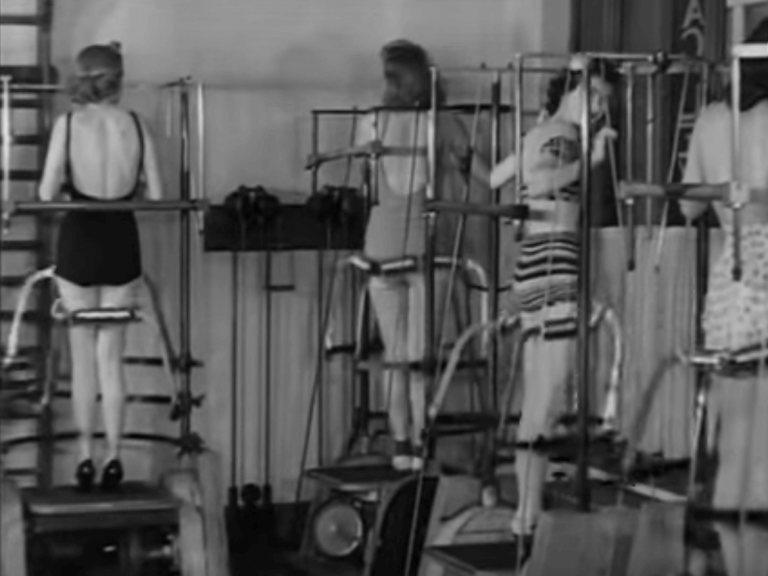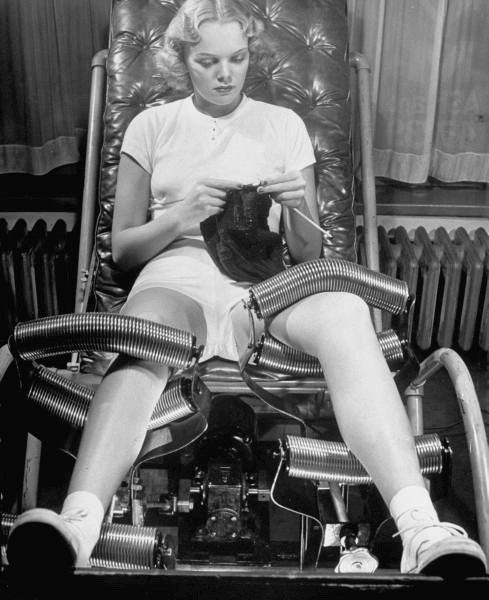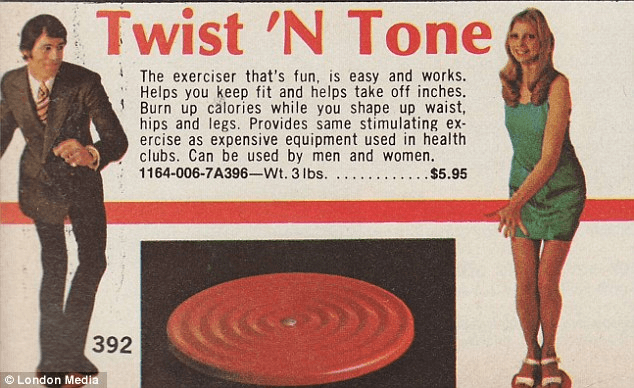Vintage Fitness Fads
It’s 5:30 am and I lie in bed, wracked with guilt. I add up all the money I’ve spent on my gym membership and compare it to the number of times I’ve actually gone to the gym. “Oh well,“ I think, at least I’m contributing to the YMCA. I roll over, cuddle the cat, and wait for the automatic coffee maker to start. There has to be an easier way. If only I could attend a Slenderizing Salon instead! This 1940’s answer to weight loss and fitness was the apparent solution for a woman who wanted to be chic, slim and trim while avoiding supposedly unattractive, masculine muscle definition.
At least four decades before the Slenderizing Salon (we’ll get back to it in a bit) came into vogue, middle and upper class women began to leave behind the cocoon of Victorian sensibilities and emerge as capable athletes on the world stage. Women competed in the Olympics in the beginning of the 20th century in genteel sports such as archery and tennis. Brawny female trapeze artists were akin to sideshow Strong Men with bulging muscles and fearsome, vaudeville performances. In contrast to their pale, swooning mothers and grandmothers, this new generation of women favoured rebelliously rosy cheeks and spirited energy.
The opinions of physical educators such as Harvard University’s Dudley Sargent became popular. Sargent believed that women need not succumb to fainting spells but should engage in vigorous exercise in order to gain a healthier and more symmetrical (and according to Sargent, more attractive) “boyish” figure. His detractors argued that a woman’s exercise mustn’t be too vigorous for fear that her uterus could ‘dislodge’. A balance was struck with fashionable sports such as women’s basketball, which was a less robust version than the game played by men.
By the 1920s, Sargent’s ideal feminine frame was extremely sought after, as evidenced by fashions of the time which hung loosely off the body. It had become important to know one’s weight, eat very carefully (sometimes very restrictive diets), and engage in aerobic exercise at home.
During this period, Reducing Records were a popular form of private physical training. Ladies were encouraged to “get thin to music” at home along with Wallace M. Rogerson by using his sensibly named “Dictated by Wallace” series of 78 rpm records. The records even included handy instructional images. Sitting on the floor with legs outstretched, the “fitness-control” pupil is instructed to lift one leg at a time into the air. A plinky orchestral recording plays in the background as Wallace firmly calls out, “one, two, one, two” and “right, left, right, left”. His thin voice sounds like he’s a tiny drill sergeant in a tin can.
Reducing Records were so popular that companies with fit-sounding names such as New York’s Health Builders Inc. even sold their own portable, wind-up phonographs for $25 (about $360 in today’s money). Easy and accessible fitness was already a growth industry.
Reducing records continued to be popular through the next few decades. During WW2, many women had no trouble staying fit as they worked on farms, in factories, or took on other manual labour. However, for those in the home or office, staying slim continued to be a concern. What to do? Attend a Slenderizing Salon, of course!
“Girls, it seems that after you’ve helped to win the war, you’ll still have another battle on your hands and legs and things” says the British narrator of a 1940’s newsreel segment called “The Battle of the Bulges,” which shows the latest mechanized units rubbing and rolling up and down the bodies of stationary women. The narrator tells women to attend in order to look like a “Sea Nymph,” and have health and happiness. They needed only to stand, sit, or lie down and allow springs and rollers to move over their various body parts in order to stimulate muscles and burn calories. With names like the “Back Ring Roller”, the “Slendo Massager,” and the “Wooden Barrel Massager,” these machines sound as terrifying as they look. However, it sure seems easier than running on a treadmill.
By the 1960s, dance was a popular form of at-home exercise. Twisting the pounds away on a Twist ‘N Tone could be done to specialized records or along to your favourite songs. One could get even more satisfaction from their exercise routine by wearing a Sauna Suit. The suit of rubberized material allegedly worked by creating a “steam bath” in order to “trim the waist and thighs” during exercise. According to the advertisements it was both comfortable and effective. The advertisement doesn’t mention anything about how one smelled after exercising in rubber and plastic. My own grandmother had one of these suits and I wish that she were alive today to share her opinion on it!
For women, exercise in the early part of the 20th century was both freeing from the restrictions of previous generations while still being fraught with complicated and conflicting messages about ideal body shape. While we are still trying to navigate sexism and shame when it comes to exercise and physical health, I am glad that women’s access to public sport and fitness continues to improve and equalize. I’m also glad to know that I come from a long line of women who would also rather cut a few corners when it comes to their own fitness routines!



